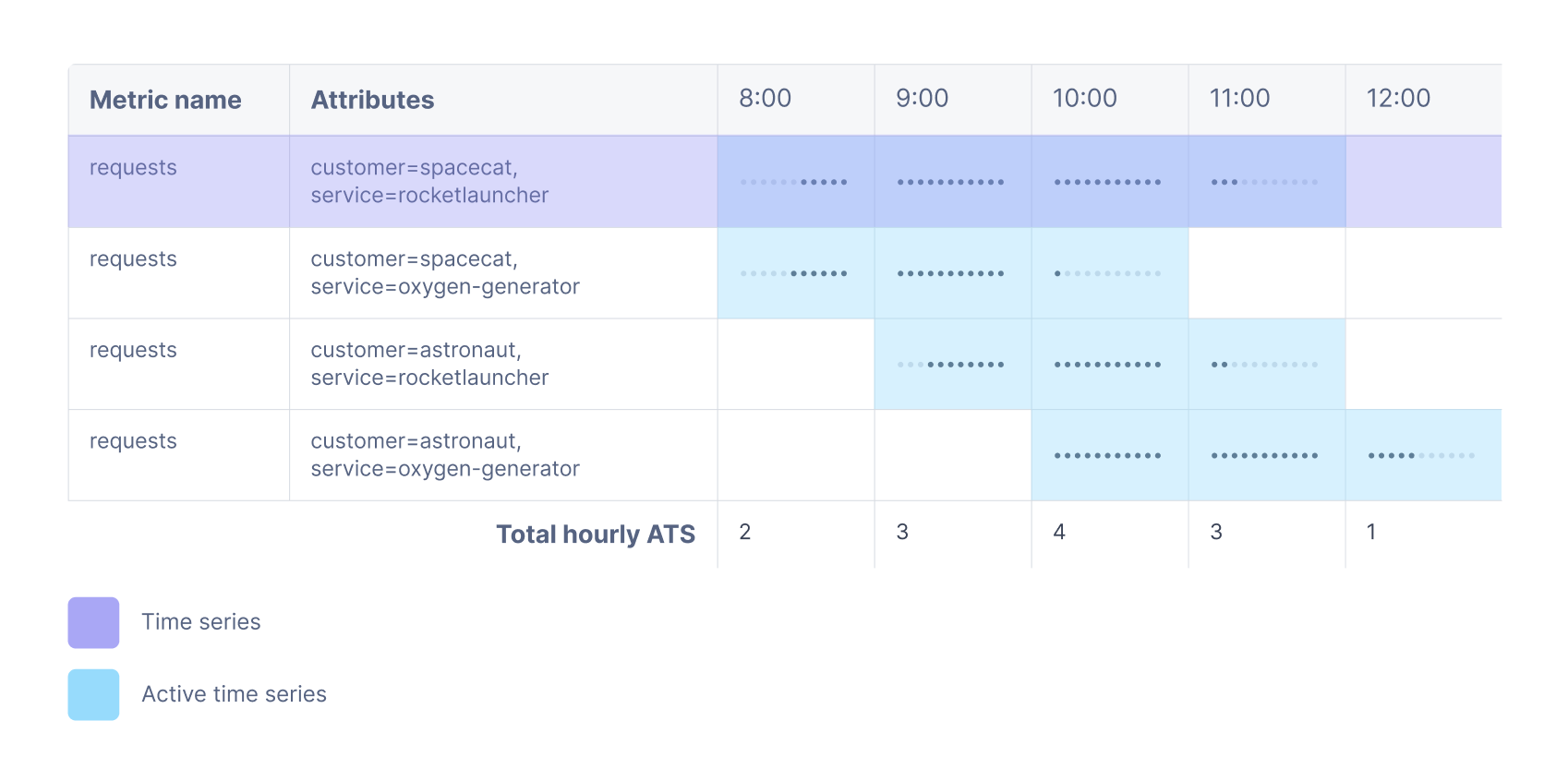Learn how Cloud Observability billing works.
This page describes Cloud Observability’s billing plans, how to calculate Active Time Series (ATS), and who can access billing features.
Visit Cloud Observability’s pricing page to learn about pricing, and contact your customer success representative with any questions.
Understanding billing plans
Cloud Observability has two billing plans. The Subscription unit plan applies to users with contracts starting on or after May 4, 2023. All other users are on the Active service bundle plan. Click these tabs to learn about the plans:
-
Under Cloud Observability’s Subscription unit plan, you purchase a monthly number of subscription units. You then apply those subscription units to Cloud Observability telemetry.
The table below shows how the different telemetry types map to one subscription unit. Note that you can always purchase more subscription units by contacting your customer success representative.
Telemetry Quantity = 1 subscription unit Log data cold retention 200 GB-days Log data hot retention 40 GB-days Log data ingest 20 GB Metrics 25 ATS Trace data ingest 10 GB Trace data retention 32 GB-days The metrics telemetry type includes the following:
- Application metrics sent to Cloud Observability.
- Infrastructure metrics sent to Cloud Observability.
- Span-derived metrics, also known as streams.
-
Cloud Observability’s Active service bundle plan is based on an active bundle. Each bundle in your contract includes an allotment of data for each billing period across these products:
-
Active Service Bundle: Distinctly named services reporting to Cloud Observability and the associated allotment of data for that bundle.
Billing is determined by the service’s name. If multiple projects have the same-named service reporting to them, you’re billed for only the one service.
- ATS: The number of unique metric time series sent to Cloud Observability, pro-rated by the hour.
- Logs (GB): The gigabytes of log data sent to Cloud Observability.
-
Span Data (GB): The gigabytes of span data sent to Cloud Observability.
- Streams: The number of existing Streams (including retained span queries).
Usage of the allotment is summed across all products in your organization for a billing period. Note an active service used across projects (for example, in staging and production) is billed as a single service.
When you use more than the contracted limit of ATS, Span Data (GB), or Streams, you incur overage charges for the exceeded amount. When you use more than the contracted limit of Active Services, you incur overage charges for additional bundles. Cloud Observability provisions additional bundles for each extra service and then updates the underlying included allowances of ATS, span data (GB), and Streams to account for the additional bundles. This ensures that you are not double charged for any overages for those items.
-
How Active Time Series are calculated
Active Time Series (ATS) are part of your Cloud Observability bill. The table below shows how Cloud Observability calculates ATS for sample data from 8:00 to 12:00.
The table has four time series – time series are unique metric-name-and-attribute combinations. A time series is active if you send at least one data point to it in an hour:
- In the 8:00 hour, there are 2 hourly ATS.
- In the 9:00 hour, there are 3 hourly ATS.
- In the 10:00 hour, there are 4 hourly ATS.
- In the 11:00 hour, there are 3 hourly ATS.
- In the 12:00 hour, there is 1 hourly ATS.
If you got a Cloud Observability bill for this time frame, you’d have 2.6 total ATS (13 hourly ATS / 5 hours).

If your metric is a distribution type (that is, it aggregates values by percentiles), Cloud Observability bills it as five separate ATS.
Accessing billing features
Your access to billing features depends on your Cloud Observability user role. This table lists billing activities and what the different user roles can do.
| Billing activities | Organization Billing Admin | Organization Admin | Organization Editor | Organization Viewer |
|---|---|---|---|---|
| Create, edit, and delete metric ingestion rules | ✔ | |||
| Export billing information to CSV | ✔ | |||
| Get emails about billing warnings and overages | ✔ | |||
| View contract details | ✔ | ✔ | ||
| View metric ingestion rules | ✔ | ✔ | ✔ | ✔ |
| View usage and overage percentages | ✔ | ✔ | ✔ | ✔ |
| [For Active service bundle plans only] View overage costs | ✔ |
Only Cloud Observability Customer Success representatives can assign the Organization Billing Admin role. Contact your Customer Success representative to assign or reassign the Organization Billing Admin role.
Billing emails
Organization Billing Admins receive an email from Cloud Observability when the account:
-
Approaches an allotment limit.
For Subscription unit plans, Organization Billing Admins get emails when the account goes above 80% and 100% of the monthly subscription-unit limit.
-
Incurs overage charges.
Only users on the Active service bundle plan can experience overages and receive overage-related emails.
Next steps
Visit the links below to learn more about monitoring Cloud Observability usage and billing.
See also
Control costs with ingestion rules
Updated Jan 29, 2025
